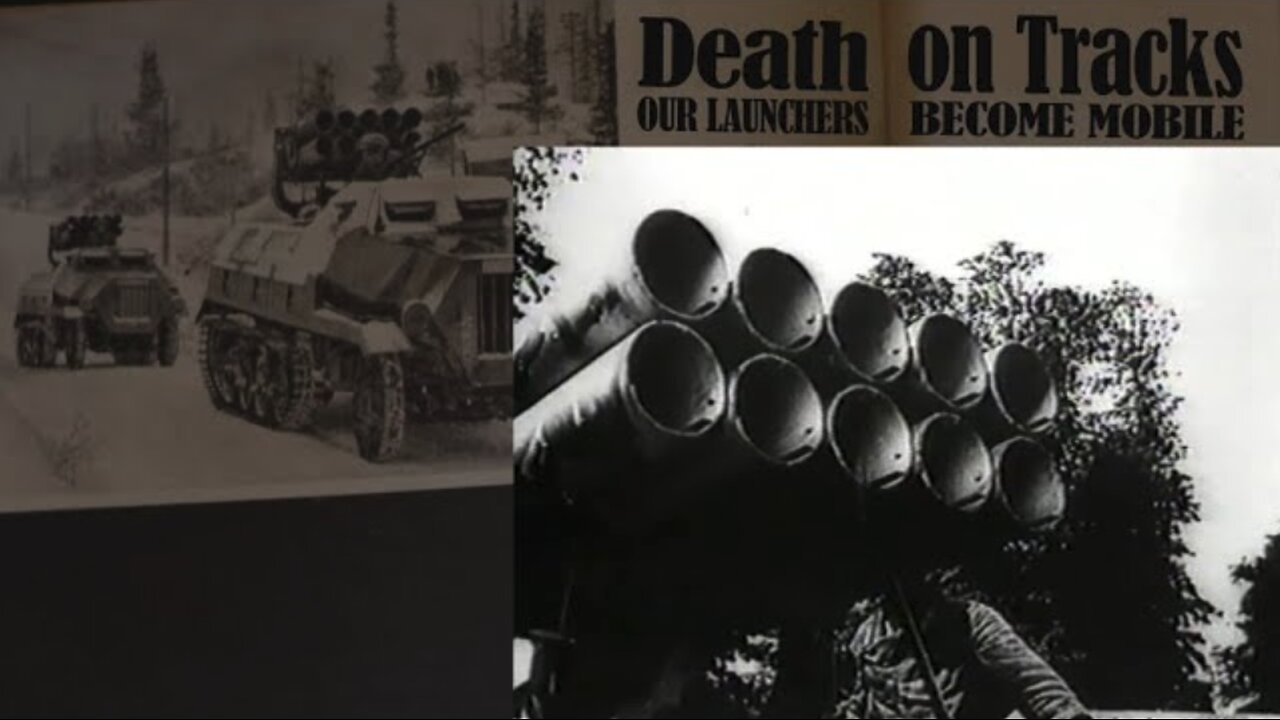Premium Only Content

Die Wehrmacht 1944 Nr 4 Pt 1 - Rocket Launcher - Panzerwerfer 42 - Guderian - Katyusha - Nebelwerfer
SUPPORT THE CHANNEL
www.Patreon.com/Military1945
Die Wehrmacht Ausgabe A 1944
https://filmhauer.net/wehrmacht-1944-ausgabe-normal-p-31786.html
This Norwegian newsreel from 1944 fits in well with the cover of this periodical which shows reconessaince team in Winter conditions. It’s from the series Die Wehrmacht and is an Ausgaba A special edition from February 23, 1944, Nr. 4.
Its first article describes the evolution from the rocket launcher to the tracked Panzerwerfer 42. Using the article as a framework and adding photographs and showing rare film footage I’ll introduce the weapon platform’s development and characteristics and we’ll see it in action.
This weapon system is effective both on the attack and in defense. The sound of the screaming rocket barrage lets the infantry knows that help is here. That sound alone is also capable of often forcing the enemy to break off its attack. The deciding factor in the use of this weapon system is its maneuverability which is key when positioning the battery so that it can attack the enemy effectively. After firing it must also be capable of quickly moving out of the operational area because the enemy uses all of its resources to find and destroy this feared weapon. The trick is to constantly change locations and continue harassing the enemy relentlessly.
Arriving to a new operational location, the process of preparing to fire is extensive. In order to reduce the complication, the rocket system has been mounted on a tracked platform. Now able to master the most difficult of terrain, the German rocket platform is more deadly than ever.
That’s not an accurate description of how development of the Panzerwerfer came about. With the invasion of the Soviet Union in the summer of 1941, the Wehrmacht commanders were impressed by the destructive capability of the Soviet Katyusha which first rolled into battle on July 14 and so began requesting something similar.
The endangered breakthrough location is reached. Seconds later the rocket launcher is loaded and ready to fire. A Panzergrenadier manning an MG for short-range defense.
A battery of Panzerwerfer drive in the direction of a Soviet breakthrough. Because of the tracks, the vehicles are able to travel over the frozen ground at high speed towards the ordered area of operation. The crew of the Panzerwerfer sit well protected from infantry fire by the vehicles body armor.
To say that they were well protected is a bit overstated. Built for lightness and mobility the vehicle’s armor was thick enough to protect against most shrapnel and small arms fire but little else. For close quarters fighting the Panzerwerfer’s only defense was the mounted MG 34 or 42 machine gun and the hand held Panzerschreck anti-tank weapon.
As can be seen in this photo, when loading the rock launcher the crew was quite vulnerable.
This is the back of the vehicle. A large double hatch in the rear plate was the main entrance to the crew compartment. There were three stowage bins on each side above the tracks.
Looking in from the back we see the gunner’s seat and hand crank mechanism that is used for rotating and aiming the launcher. Along both sides of the interior are ammunition racks. Above the racks is space for two Panzerschreck anti-tank weapons to be kept.
The operational area near the critical point where the Soviets have broken through is reached. Only seconds later the launcher is loaded and ready to fire. A Panzergrenadier protects the exposed crew that is hard at work with the mounted machine gun.
This text of course implies that the Panzerwerfer was not able to travel with its rocket launcher loaded. Although it would supposedly only take a few seconds to prepare for firing, the crew would be exposed, which would otherwise be an unnecessary risk.
The Panzerwerfer 42 was certainly an effective weapon but it also had its problems. Namely, they were expensive to build and their ammunition was an unusual size which meant that special ammunition transporters also had to be produced. This made mass production more difficult. In addition the Panzerwerfer 42’s rockets didn’t have fins which made them less accurate than the Soviet Katyusha.
By the end of 1943 a new launcher system had been developed in the Czech city of Brno which more closely resembled its Soviet counterpart.
The rockets retained the Soviet 8.2cm caliber and were fin-stabilized which, when fired, spun and made them more accurate.
The prototype was fitted with 4 rails bearing 96 rockets, but such a construction appeared to be too bulky. The production version retained only 2 rows with 48 rockets. Very few of these machines were built and those that were saw little combat.
These photos are from a film reel from mid 1944 that show this hybrid rocket launcher being demonstrated to Guderian. If you are a Patreon Channel Member you have access to see this sensational footage, if not, please consider becoming one.
-
 9:16
9:16
Military1945
2 months ago2nd Mountain Div. Pt 2 - Regiment 136 - German-Soviet Frontier Treaty 28.9.39 - Valentin Feurstein
1361 -
 4:58:51
4:58:51
Steven Crowder
12 hours agoLIVE: No Kings Day - Following The Money w/ Guest: Data Republican | Louder with Crowder
778K403 -
 1:11:45
1:11:45
Man in America
10 hours ago🚨 America Descends Into CHAOS—Are You Prepared?
58.7K55 -
 2:23:54
2:23:54
Badlands Media
1 day agoDevolution Power Hour Ep. 363: Lawfare, Psyops, and the Great Narrative Reversal
76.6K19 -
 2:32:48
2:32:48
Tundra Tactical
5 hours ago $6.93 earnedSilencers, Senators, and Survival: Roasting Lies and a Security Breakdown of The MN Shooting
42.8K5 -
 LIVE
LIVE
Spartan
9 hours agoPro Halo Player | !politics Halo Infinite Ranked Arena into SWTOR and/or Gears Beta
241 watching -
 40:25
40:25
The Connect: With Johnny Mitchell
1 day ago $7.43 earnedBlackwater CEO Erik Prince Gets HONEST About The Israeli Invasion Of Lebanon
36.7K38 -

BlackDiamondGunsandGear
6 hours agoAfter Hours Armory / Is the World ENDING?
59.5K3 -
![[NEW] FIVE NIGHTS AT FREDDY'S - SECRET OF THE MIMIC - Horror Game](https://1a-1791.com/video/fww1/cb/s8/1/F/2/r/T/F2rTy.0kob-small-NEW-FIVE-NIGHTS-AT-FREDDYS-.jpg) 4:21:28
4:21:28
cosmicvandenim
7 hours ago[NEW] FIVE NIGHTS AT FREDDY'S - SECRET OF THE MIMIC - Horror Game
74K1 -
 2:14:37
2:14:37
DLDAfterDark
6 hours ago $1.17 earnedThe After Hours Armory - WWIII - The World Is Melting - Feat. Gideon Optics
36.2K3